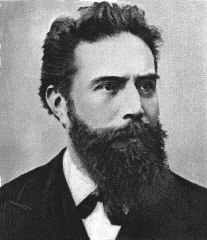
March 27, 1845 - Wilhelm Conrad Ršntgen was born at Lennep in Germany.
1865 - Entered the University of Utrecht to study physics. From not having attained the credentials required for a regular student (from being expelled from high school), he passed Polytechnic at ZurichŐs examinations, and began studies as a student of mechanical engineering. He attended the lectures given by Clausius and was able to work in the laboratory of Wolfgang Kundt, another German physicist.
1869 - Graduated with a Ph.D. at the University of Zurich.
1870 - Ršntgen's first work was published. This dealt with the specific heats of gases. A few years later, a paper was published on the thermal conductivity of crystals.
1872 - Ršntgen married Anna Bertha Ludwig of Zźrich.
1874 Đ Became a lecturer at Strasbourg University.
1875 - Appointed to Professor in the Academy of Agriculture at Hohenheim in Wurtemberg.
1876 - Returned to Strasbourg as Professor of Physics
1879 Đ Became Chair of Physics in the University of Giessen.
1886 Đ Declined job at the University of Jena 1888 Đ Declined job at the University of Utrecht.
1888 Đ Accepted job at the University of Wźrzburg. There he worked with Helmholtz and Lorenz.
1895 Đ Studied the phenomena of an electric current through a gas of extremely low pressure.
November 8, 1895 Đ While at the University of Wźrzburg, Ršntgen's attention was drawn to a glowing fluorescent screen on a nearby table. He immediately determined that the fluorescence was caused by invisible rays originating from the partially evacuated glass Hittorf-Crookes tube, that he was using to study cathode rays.
March 9, 1896 Đ Published his second article on X-rays March 10, 1897 Đ Published his third article on X-rays.
1899 Đ Declined job to become Chair of Physics at the University of Leipzip.
1900 Đ Accepted job to become Chair of Physics at the University of Munich. Here he stayed for the rest of his life, although he declined the Presidency of the Physikalisch-Technische Reichsanstalt at Berlin, as well as the Chair of Physics of the Berlin Academy.
1901 Đ Ršntgen received the first Nobel Physics Prize.
1912 - Max von Laue, Walther Friedrich and Paul Knipping discovered that X-rays are closely similar to light.
1919 Đ RšntgenŐs wife, Anna Bertha Ludwig, died.
February 10, 1923 - Ršntgen died in Munich from carcinoma of the intestine.
ADVANCEMENTS
and IMPORTANCES
FUN FACTS AND PICTURES